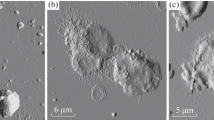Summary
Peritoneal fluid cells of rats were grown in intraperitoneal implanted diffusion chambers. By cytological and histochemical methods the development of these cells was studied. Many cells died in the chambers which were implanted for 1 to 5 days; by this time eosinophil granulocytes and mastcells mostly had disappeared. During the first 3 days roundshaped macrophages predominated in the cultures. After the 5th day most macrophages had a spindleshaped appearance. Fibroblasts, rarely seen on day 3, often were found after the 5th day, their number slightly increased until the 15th day. In about 3% multinuclear giant cells could be observed. Roundshaped and spindleshaped macrophages were rich in acid phosphatase, fibroblasts usually were enzyme negative. In the multinuclear giant cells enzyme activity was preferentially located in the cytoplasma near the nuclei. For cells of the surrounding peritoneal tissue could not penetrate the filter membranes, the fibroblasts must have been originated from cells which were filled into the diffusion chambers. It is assumed that mononuclear round cells of the peritoneal fluid are able to transform into fibroblasts.
Zusammenfassung
Mit cytologischen und histochemischen Methoden wurde die Differenzierungsfähigkeit von Peritonealflüssigkeitszellen von Ratten in intraperitoneal implantierten Diffusionskammern untersucht. Ein Teil der transplantierten Zellen ging in den ersten Versuchstagen unter. Vom 3. Tag an zeigten die Zellen einen Strukturwandel. Die rundzelligen Makrophagen nahmen bis zum 5. Versuchstag ab, die spindelförmigen Makrophagen, die in geringer Anzahl schon am 1. Versuchstag vorhanden waren, nahmen bis zu diesem Zeitpunkt zu. In größerer Anzahl traten Fibroblasten erstmals am 5. Versuchstag auf, ihre Anzahl stieg bis zum Versuchsende gering an. Diese Zellen lagen im Gegensatz zu den Makrophagen in synzytialen Verbänden. Während die rundzelligen und spindelförmigen Makrophagen eine starke Aktivität an saurer Phosphatase aufwiesen, waren die Fibroblasten meist enzymnegativ. Es wird angenommen, daß die Fibroblasten aus den mononucleären Rundzellen hervorgehen und am 5.–7. Kulturtag ihre endgültige Struktur entwickelt haben.
Similar content being viewed by others
Literatur
Allgöwer, M., Hulliger, L.: Origin of fibroblasts from mononuclear blood cells: a study on in vitro formation of collagen precursor, hydroxypoline, in buffy coat cultures. Surgery47, 603–610 (1960).
Barnes, D. H. W., Khrushchov, N. G.: Fibroblasts in sterile inflammation: study in mouse radiation chimaeras. Nature (Lond.)218, 599–601 (1968).
Benestad, H. B.: Formation of granulocytes and macrophages in diffusion chamber cultures of mouse blood leucocytes. Scand. J. Haemat.7, 279–288 (1970).
Büchner, Th.: Entzündungszellen im Blut und im Gewebe. Veröff. morph. Path., Heft 86. Stuttgart: Fischer 1971.
Büchner, Th., Junge-Hülsing, G., Wagner, H., Oberwittler, W., Hauss, W. H.: Zur Herkunft und Entstehung von Entzündungszellen im Granulationsgewebe. Klin. Wschr.48, 867–872 (1970).
Carl, H.: Inaug.-Diss., Ulm 1971.
Curran, R. C., Clark, A. E.: Phagocytosis and fibrogenesis in peritoneal implants in the rat. J. Path. Bact.88, 489–502 (1964).
Eskeland, G.: Growth of autologous peritoneal fluid cells in intraperitoneal diffusion chambers in rats. Acta path. microbiol. scand.68, 481–500 (1966).
Gillman, T., Wright, L. J.: Autoradiographic evidence suggesting in vivo transformation of some blood mononuclears in repair and fibrosis. Nature (Lond.)209, 1086–1090 (1966).
Goldberg, A. F., Barka, T.: Acid phosphatase activity in human blood cells. Nature (Lond.)195, 297 (1962).
Grillo, H. C.: Origin of fibroblasts in wound healing. Ann. Surg.157, 453–467 (1963).
Hadfield, G.: The tissue of origin of the fibroblasts of granulation tissue. Brit. J. Surg.L, 870–881 (1963).
Hjortdal, O., Rasmussen, P.: In vitro culture of blood cells. Acta anat. (Basel)72, 304–319 (1969).
Hulliger, L.: Über die unterschiedlichen Entwicklungsfähigkeiten der Zellen des Blutes und der Lymphe in vitro. Virchows Arch. path. Anat.329, 289–318 (1956).
Hulliger, L., Allgöwer, M.: Proliferation und Differenzierung monozytärer Zellen des peripheren Blutes. Schweiz. med. Wschr.40, 1201–1202 (1961).
Jacoby, F.: Macrophages. In: Willmer, E. N. (Hrsg.), Cells and tissue in culture, Bd. 2, S. 1–93. London-New York: Academic Press 1965.
Khrustchov, N. G., Kruglikov, G. G., Komarouitch, N. J.: Agranulocytes of blood as a neoformation source of fibroblasts of connective tissue in inflammation focus. Arkh. Anat. Gistol. Embriol.56, 3–5 (1969).
Kouri, J., Ancheta, O.: Transformation of macrophages into fibroblasts. Exp. Cell Res.71, 168–176 (1972).
Maximow, A.: Über das Mesothel (Deckzellen der serösen Häute) und die Zellen der serösen Exsudate. Arch. exp. Zellforsch.4, 1–37 (1927).
Meints, R. H., Vazant, G.: Erythropoiesis in diffusion chambers during hypoxia. Life Sci.8, 1041–1045 (1969).
Mohr, W., Beneke, G., Carl, H.: Proliferation von Peritonealflüssigkeitszellen in implantierten Diffusionskammern. Beitr. Path.144, 63–79 (1971).
Noack, W.: Elektronenmikroskopische Untersuchungen über die Entstehung von Phagozyten und Fibroblasten auf peritonealen Implantaten. Blut21, 35–47 (1970).
Petrakis, N. L.: In vivo cultivation of leucocytes in diffusion chambers: Requirement of ascorbic acid for differentiation of mononuclear leucocytes to fibroblasts. Blood18, 310–316 (1961).
Ross, R., Lillywhite, J. W.: The fate of buffy coat cells grown in subcutaneously implanted diffusion chambers. Lab. Invest.14, 1568–1585 (1965).
Ross, R., Everitt, N. B., Tyler, R.: Wound healing and collagen formation. J. Cell. Biol.44, 645–654 (1970).
Shelton, E., Rice, M. E.: Growth of normal peritoneal cells in diffusion chambers: A study in cell modulation. Amer. J. Anat.105, 281–303 (1959).
Still, W. J. S., Ghani, A. R., Dennison, S. M.: The organization of isolated mural thrombi in aortic grafts. Amer. J. Path.51, 1013–1029 (1967).
Stirling, G. A., Kakkar, V. V.: Cells in the circulating blood capable of producing connective tissue. Brit. J. exp. Path.50, 51–55 (1969).
Willard, H. G., Hoppe, J. B. H., Nettelsheim, P.: Mouse leucocytes in culture. Proc. Soc. exp. Biol. (N.Y.)118, 993–996 (1965).
Author information
Authors and Affiliations
Additional information
Die Untersuchungen wurden mit finanzieller Unterstützung durch die Deutsche Forschungsgemeinschaft durchgeführt.
Rights and permissions
About this article
Cite this article
Mohr, W., Carl, H. & Beneke, G. Untersuchungen zur Herkunft von Fibroblasten in Kulturen (Diffusionskammern) von Peritonealflüssigkeitszellen der Ratte. Res. Exp. Med. 158, 251–267 (1972). https://doi.org/10.1007/BF01852209
Received:
Issue Date:
DOI: https://doi.org/10.1007/BF01852209




